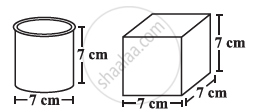Advertisements
Advertisements
Question
Three equal cubes are placed adjacently in a row. Find the ratio of the total surfaced area of the resulting cuboid to that of the sum of the total surface areas of the three cubes.
Solution
Let the side of a cube be 'a' units.
The total surface area of one cube = 6a2
The total surface area of 3 cubes = 3 x 6a2 = 18a2
After joining 3 cubes in a row, length of Cuboid = 3a
Breadth and height of cuboid = a
The total surface area of the cuboid = 2( 3a2 + a2 + 3a2 ) = 14a2
The ratio of total surface area of a cuboid to the total surface area of 3 cubes = `(14a^2) /(18a^2) = 7/9`
APPEARS IN
RELATED QUESTIONS
Describe how the two figures at the right are alike and how they are different. Which box has larger lateral surface area?

Find the volume of a cube whose side is 1.2 m .
Fill in the blank in the following so as to make the statement true:
1 litre = ....... cubic decimetre
Total surface area of a cube is 5400 sq. cm. Find the surface area of all vertical faces of the cube.
Three cubes, whose edges are x cm, 8 cm, and 10 cm respectively, are melted and recast into a single cube of edge 12 cm. Find 'x'.
When the length of each side of a cube is increased by 3 cm, its volume is increased by 2457 cm3. Find its side. How much will its volume decrease, if the length of each side of it is reduced by 20%?
A solid cube of side 12 cm is cut into 8 identical cubes. What will be the side of the new cube? Also, find the ratio between the surface area of the original cube and the total surface area of all the small cubes formed.
The volume of a cube is 1331 cm3. Find its total surface area.
Find the volume of a cube whose diagonals is `sqrt(48)"cm"`.
If the lateral surface area of a cube is 600 cm2, then the total surface area is
